[This piece was co-authored by Jake Truscott, a Post-Doctoral Researcher for C-SPAN Scholarship and Engagement]
It has been another crazy year before the Supreme Court as the justices took up important cases related to Affirmative Action, student debt, voting, and religious rights among other issues. The justices decided several of these important cases along ideological lines. This direction of the current Court was really set in motion a couple of terms ago. The Court changed dramatically in 2020 when Justice Barrett took Justice Ginsburg’s seat and formed a conservative supermajority. This shift in the Court was one of the most significant in the last 30+ years along with the replacement of Justice Alito for O’Connor and Thomas for Thurgood Marshall.
This term began with a shift in oral arguments like we’ve never seen before. The main distinction this term was that with the addition of Justice Jackson we saw the most active new justice at oral arguments probably in the history of the Court and definitely over the past 30+ years. Justice Jackson not only spoke more than any new justice, but she also spoke more than any justice sitting justice during this period with the exception of the Chief Justice in two instances (who most likely only spoke more due to formal institutions of the Court including having the Chief open and close each argument).
Did this impact case outcomes? While we don’t yet know for certain, Justice Jackson was in the majority 84% of the time and this is more than other progressive justices from the prior term.
Voting Coalitions
Justice Jackson’s participation in the majority was influenced by her position on the left of the Court which has clearly been the minority of the Court over the past several terms. Last term we saw the power of the 6 to 3 conservative majority as 14 of the 58 decisions came down along these lines. There were also more 6 to 3 decisions last term as a fraction of the total decisions of the Court than in any previous term in the Court’s history. The number of 6 to 3 decisions this term was 11 (ideological and non-ideological), though it would be more appropriate to note it as 12 given that Justice Jackson did not participate in one of the two Affirmative Action cases that were nonetheless consolidated into a single opinion. The graph below shows the vote split breakdown for this term along with the past several terms.
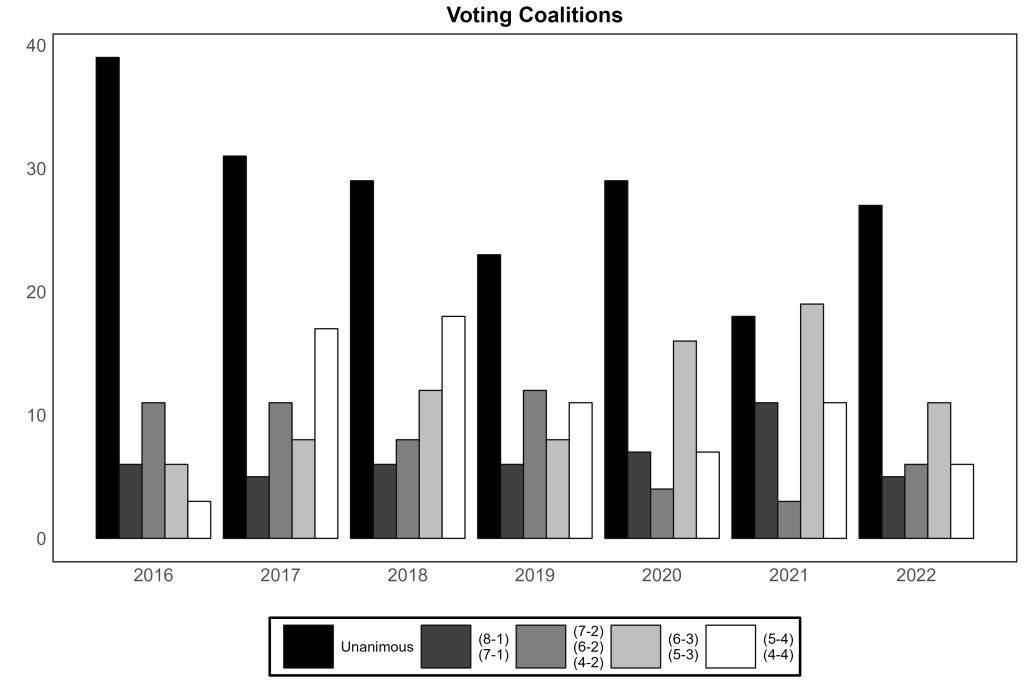
If we limit the count to ideologically split decisions, the graph looks as follows:

The five ideological split 6-3 decisions this term is a marked decrease from the 14 last term.
Voting Alignments
These vote breakdowns also stem from the justices’ alignments with one another as the supermajority is only successful as a group when all members vote together. Over the past few terms, the justices who aligned together most frequently with their votes were the combination of Chief Justice Roberts and Justice Kavanaugh, who joined the Court in 2005 and 2018, respectively. The graph below shows the justices’ voting alignments for the 2016 through 2021 Supreme Court Terms.

This term the greatest alignments were the combinations of Justices Roberts-Kavanaugh, Sotomayor-Kagan, and Jackson-Sotomayor. Justice Jackson, the newest member of the Court aligned most frequently with Justice Sotomayor and least frequently with Justices Alito and Thomas. The graph below shows all of the justices’ alignment percentages across this term.
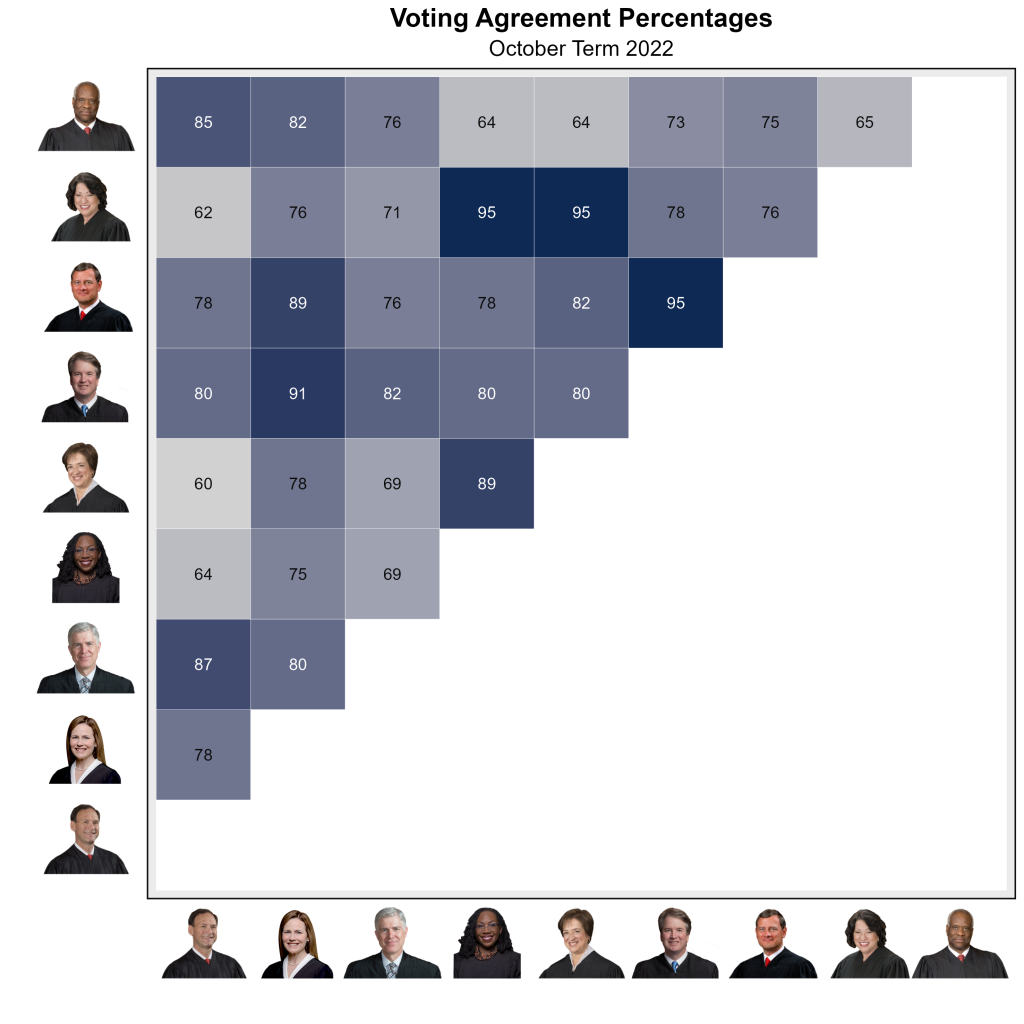
Frequency in the Majority
Another way to gauge the justices’ ability to direct opinion outcomes is through their participation in the Court’s majority. If Chief Justice Roberts is in the majority for instance, he can assign the majority opinion. The Chief Justice was in the majority 95% of the time this term, which very nearly matches the previous two terms. The graph below shows all of the justices’ frequencies in the majority this term and for the two previous ones.
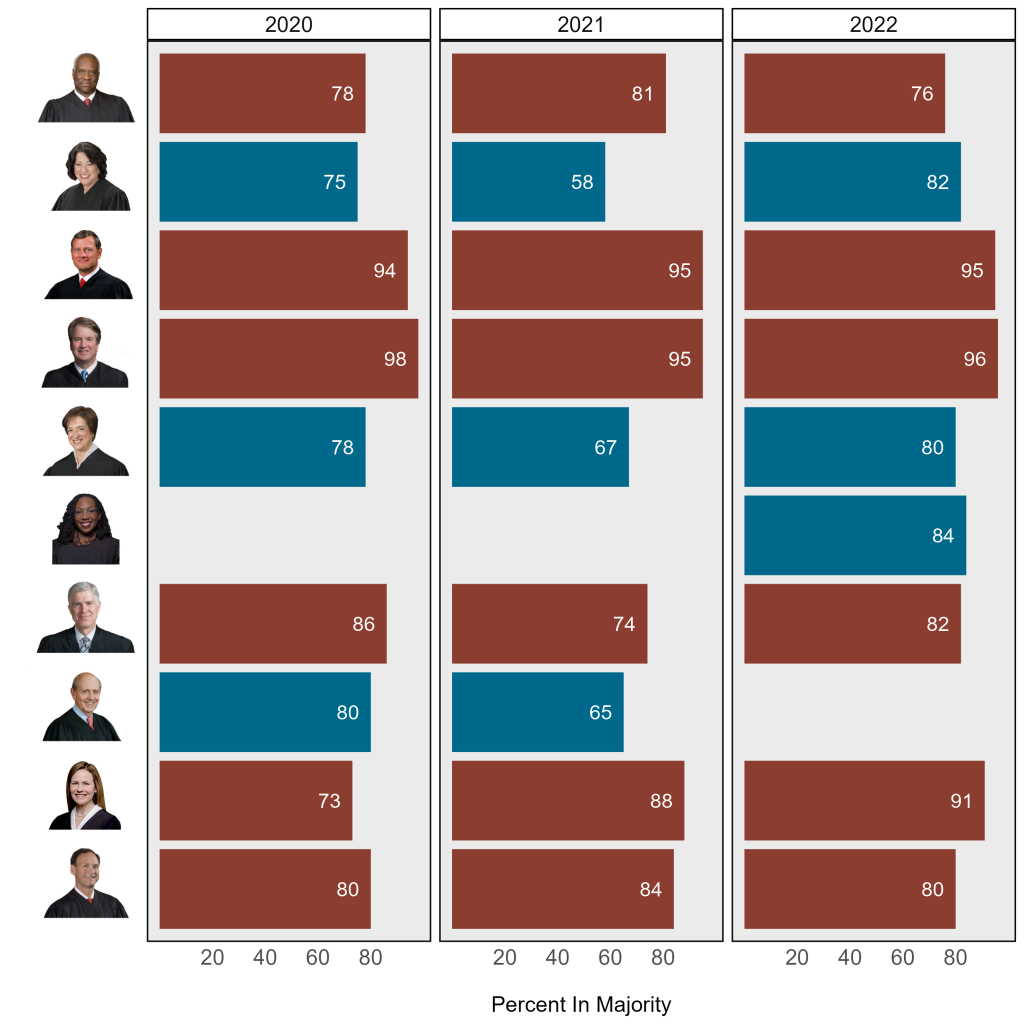
Decision Pace
This term, one of the important storylines surrounded the slow drip of opinions early in the term leading to one of the most packed Junes for opinion releases (as a percentage of Court’s total decisions for the term) ever. By jamming the majority of opinions for the term into June, the Court still disposed of its merits docket on time, albeit by the skin of its teeth.
The pace of decision releases, however, was notably slow at the beginning of the term but levelled out. This slow pace of decision released this term followed suit from the slow pace of decision releases from other recent terms.

Dissents
Much of the discussion this term has been focused on the newest justice on the Court, Justice Jackson. Justice Jackson wrote 5 majority opinions and 6 dissents. Her separate opinion count was effectively the middle of the pack. Justice Thomas led the way with 9 dissents this term, while Gorsuch had the most concurrences at 10.
Justice Jackson’s written dissents for the term are more than those from previous first term justices going back to Justice Gorsuch’s first full term in 2017 (though he was appointed during the concluding weeks of the 2016 term). What is really surprising though is the number of solo dissents compared to dissents she authored. Compared to the other three most recent justices that joined the Court – Gorsuch, Kavanaugh, and Barrett – Jackson had the largest proportion of solo authored dissents relative to total dissenting votes in the term (this includes all dissents not joined by other justices and not only dissents in 8-1 voting splits). This comes with the caveat that Justice Gorsuch did not have any solo dissents at the end of the 2016 Term when he joined the Court and neither Justices Kavanaugh nor Barrett had any solo dissents in their first terms on the Court.
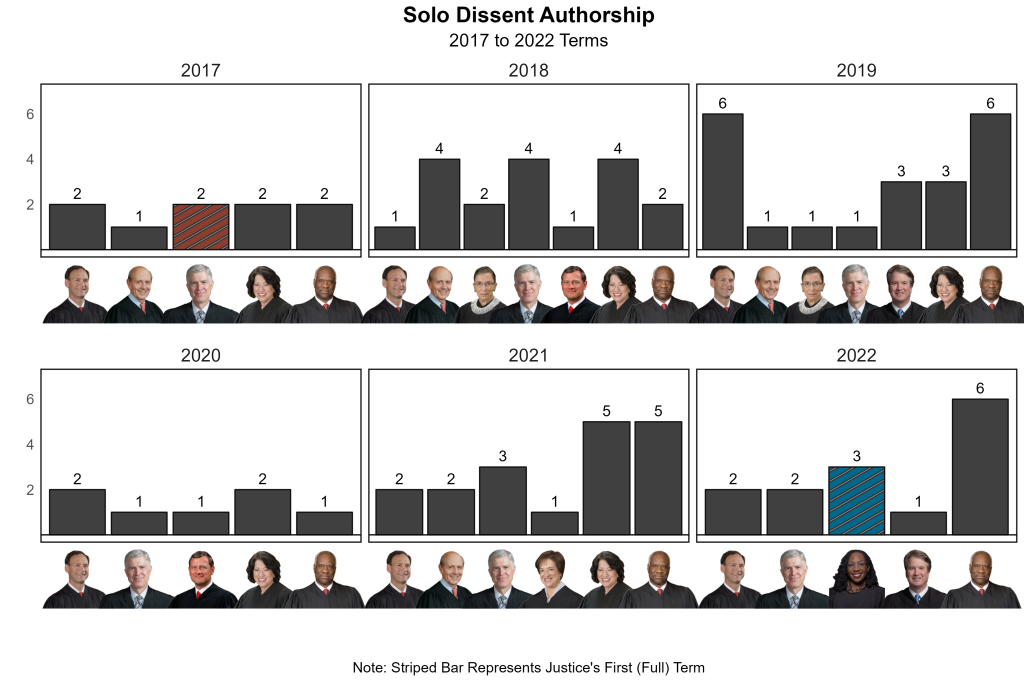
Word Counts
Perhaps even more interesting than the number of opinions is opinion length. Justice Jackson averaged approximately 5,300 words in her dissents, 4,100 in her majority opinions, and only 840 words in her concurrences. This compares with an average of over 9,000 words from Justice Sotomayor’s dissents. Below are the average word counts for all of the justices’ majority and separate opinions.
[Note: All word counts exclude words in footnotes and appendices]
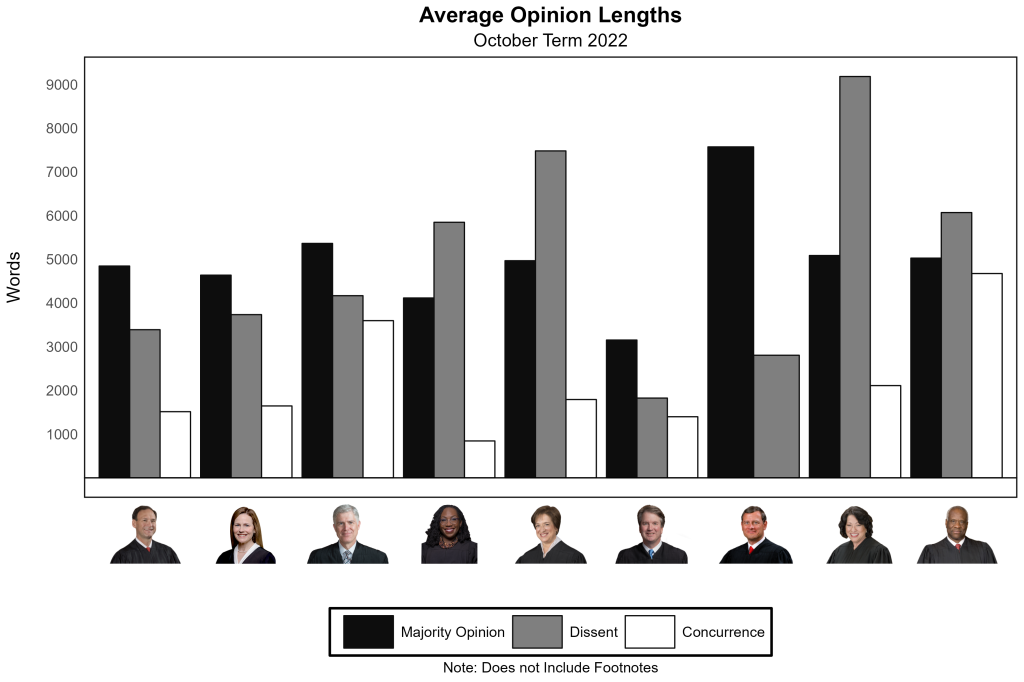
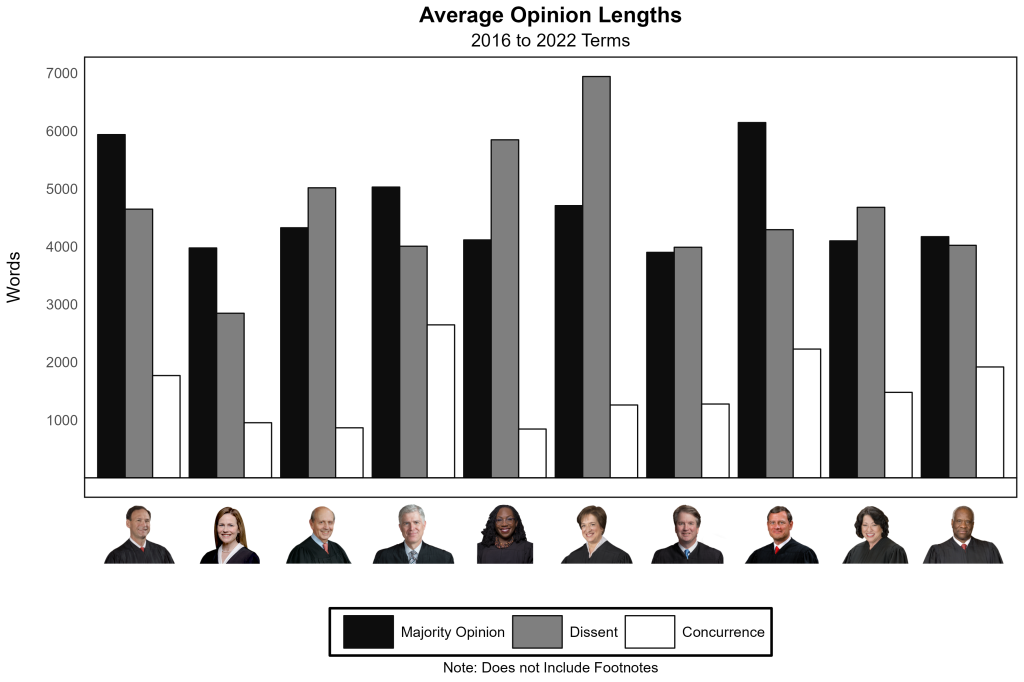
In terms of total word counts for opinions this term, Justice Thomas wrote the most and Justice Kavanaugh wrote the least.
Opinion Trends
We can also look at the total number of opinions this term for all justices as compared to the past several terms as the graph below shows.
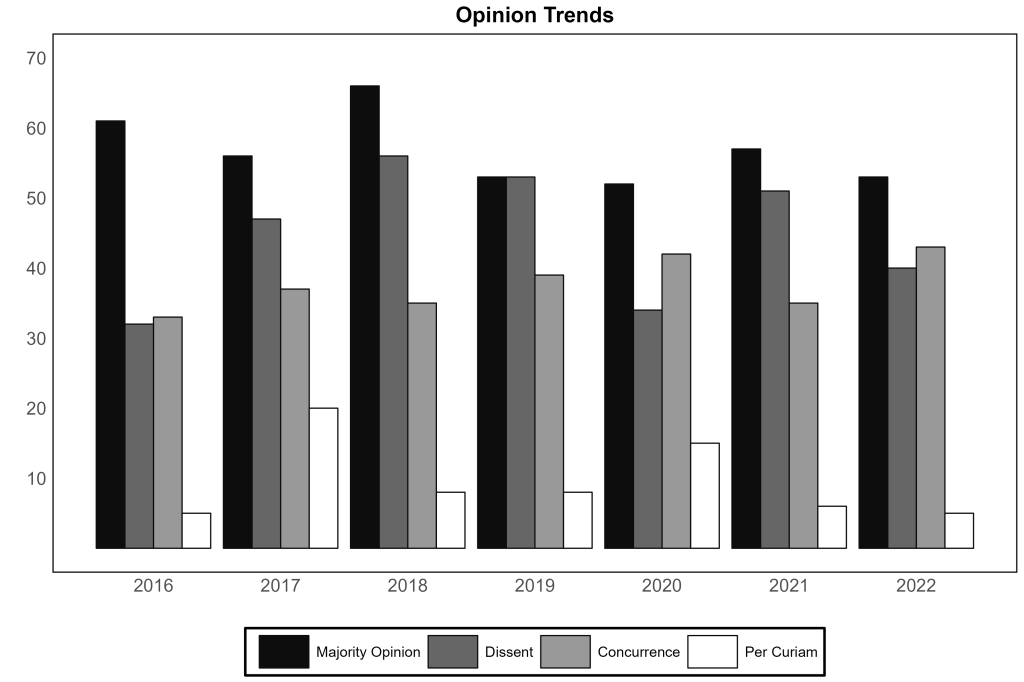
The total opinion count has been fairly consistent across the past several terms although as total caseload diminishes over time, so do total opinion counts.
Shadow Docket
Especially with the release of Steve Vladeck’s book The Shadow Docket, there has been a shift in focus to also observing how frequently the justices make decisions without the benefit of full briefing and argument. One measure of the impact of the shadow docket is through the number of emergency applications filed to the Court compared to the number of petitions for cert as we might expect more advocates to look to the shadow docket rather than the merits docket if the justices are willing to decide more cases in an expedited fashion.

We see that the number of applications has risen from approximately 880 to 1125 (as of June 28, 2023) while the number of petitions has dropped from 4900 to 4115. This evidence shows that players before the Supreme Court are aware that the justices are looking to resolve cases through the shadow docket and has played into attorneys’ calculi about how to bring cases before the Court.
Conclusion
For the cases the Court with the benefit of oral arguments and full briefing, the justices once again saved their most important decisions for the end of the term. Like last term many were decided along ideological lines. These included the highly anticipated decisions dealing with affirmative action, student debt, and the First Amendment. The Court did not, however, split ideologically in high profile cases dealing with election law and religious rights. This shows the Court with the addition of Justice Jackson moved away a bit from ideological split decisions this term, although the Court split ideologically in some of its most important decisions.
With 16 arguments based on 17 cases already set for the 2023 Supreme Court term, this coming fall has the potential to turn out quite similar to this past term. As Justice Jackson will already have one term under her belt by next term, and the rest of the justices will already have one term working with Justice Jackson, the justices’ familiarity with one another might drive the wedge between the left and right of the Court even further, even if there are certain pairings like Justice Jackson and Justice Gorsuch that sometimes vote together notwithstanding their divergent judicial and interpretive philosophies.
9 Comments Add yours